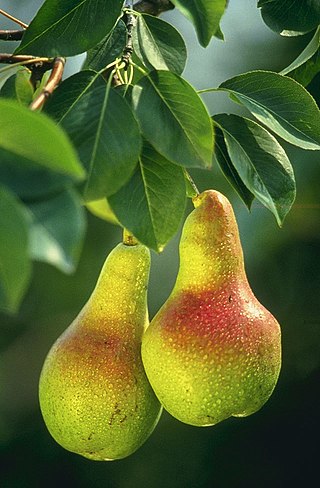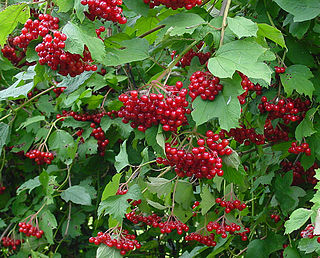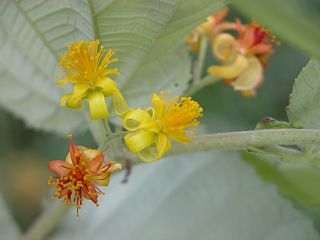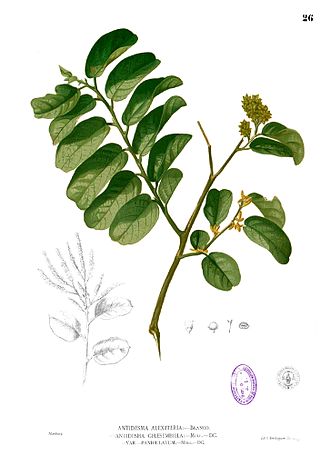
Pears are fruits produced and consumed around the world, growing on a tree and harvested in late summer into mid-autumn. The pear tree and shrub are a species of genus Pyrus, in the family Rosaceae, bearing the pomaceous fruit of the same name. Several species of pears are valued for their edible fruit and juices, while others are cultivated as trees.

Rambutan is a medium-sized tropical tree in the family Sapindaceae. The name also refers to the edible fruit produced by this tree. The rambutan is native to Southeast Asia. It is closely related to several other edible tropical fruits, including the lychee, longan, pulasan, and quenepa.

Ficus is a genus of about 850 species of woody trees, shrubs, vines, epiphytes and hemiepiphytes in the family Moraceae. Collectively known as fig trees or figs, they are native throughout the tropics with a few species extending into the semi-warm temperate zone. The common fig (F. carica) is a temperate species native to southwest Asia and the Mediterranean region, which has been widely cultivated from ancient times for its fruit, also referred to as figs. The fruit of most other species are also edible though they are usually of only local economic importance or eaten as bushfood. However, they are extremely important food resources for wildlife. Figs are also of considerable cultural importance throughout the tropics, both as objects of worship and for their many practical uses.

Viburnum is a genus of about 150–175 species of flowering plants in the moschatel family, Adoxaceae. Its current classification is based on molecular phylogeny. It was previously included in the honeysuckle family Caprifoliaceae.

Pollination of fruit trees is required to produce seeds with surrounding fruit. It is the process of moving pollen from the anther to the stigma, either in the same flower or in another flower. Some tree species, including many fruit trees, do not produce fruit from self-pollination, so pollinizer trees are planted in orchards.

The jackfruit is the fruit of jack treeArtocarpus heterophyllus, a species of tree in the fig, mulberry, and breadfruit family (Moraceae). The jackfruit is the largest tree fruit, reaching as much as 55 kg in weight, 90 cm in length, and 50 cm in diameter. A mature jackfruit tree produces some 200 fruits per year, with older trees bearing up to 500 fruits in a year. The jackfruit is a multiple fruit composed of hundreds to thousands of individual flowers, and the fleshy petals of the unripe fruit are eaten.

The rowans or mountain-ashes are shrubs or trees in the genus Sorbus of the rose family, Rosaceae. They are native throughout the cool temperate regions of the Northern Hemisphere, with the highest species diversity in the Himalaya, southern Tibet and parts of western China, where numerous apomictic microspecies occur. The name rowan was originally applied to the species Sorbus aucuparia and is also used for other species in the genus Sorbus.

The loquat, called biwa in Japan, is a large evergreen shrub or tree grown commercially for its orange fruit and for its leaves, which are used to make herbal tea. It is also cultivated as an ornamental plant.

Antidesma is a genus of tropical plant in the family Phyllanthaceae formally described by Linnaeus in 1753. It is native to tropical Africa, S + E + SE Asia, Australia, and various oceanic islands. The greatest diversity occurs in Southeast Asia.

Phyllanthaceae is a family of flowering plants in the eudicot order Malpighiales. It is most closely related to the family Picrodendraceae.

Ziziphus mauritiana, also known as Indian jujube, Indian plum, Chinese date, Chinese apple, ber and dunks is a tropical fruit tree species belonging to the family Rhamnaceae. It is often confused with the closely related Chinese jujube, but whereas Z. jujuba prefers temperate climates, Z. mauritiana is tropical to subtropical.

Pandanus tectorius is a species of Pandanus (screwpine) that is native to Malesia, Papuasia, eastern Australia, and the Pacific Islands. It grows in the coastal lowlands typically near the edge of the ocean. Common names in English include thatch screwpine, Tahitian screwpine, hala tree and pandanus. The fruit is edible and sometimes known as hala fruit.

Arum is a genus of flowering plants in the family Araceae, native to Europe, northern Africa, and western and central Asia, with the highest species diversity in the Mediterranean region. Frequently called arum lilies, they are not closely related to the true lilies Lilium. Plants in closely related Zantedeschia are also called "arum lilies".

Grewia asiatica, commonly known as phalsa or falsa, is a species of flowering plant in the mallow family Malvaceae. It was first found in Varanasi, India, and was taken by Buddhist scholars to other Asian countries including Pakistan and the rest of the world. Grewia celtidifolia was initially considered a mere variety of phalsa, but is now recognized as a distinct species.

The Madagascan fruit bat is a species of bat in the family Pteropodidae. It is endemic to Madagascar and is listed as "Vulnerable" by the IUCN because it is hunted as bushmeat.

Antidesma bunius is a species of fruit tree in the family Phyllanthaceae. It is native to South Asia, Southeast Asia, Melanesia, and northern Australia. It is commonly known as bignay, after its native name in the Philippines, where the fruits are commonly used for making bignay wine and jams. It is also known more ambiguously as Chinese laurel, Queensland cherry, salamander tree, wild cherry, and currant tree.
The micrantha is a wild citrus from the papeda group, native to southern Philippines, particularly islands of Cebu and Bohol. Two varieties are recognized: small-flowered papeda, locally known as biasong, and small-fruited papeda or samuyao.

Antidesma acidum is a shrub or small tree that is native to an area from Jawa to south-central China and Pakistan. It is a long-lived, shade-tolerant species that is usually found under closed-canopy. The fruit is eaten in many places, the leaves in some locations. In Luang Prabang (Laos) open-air markets, the leaves are only sold alongside Russula mushrooms, to give a sour flavour to soup made from the fungi.

Antidesma ghaesembilla is a species of plant in the Phyllanthaceae family. It is native to an area from northern Australia to the Philippines, China, and west to India. The shrub or tree usually grows in moist soils in plant communities ranging from savannah to gallery forest to closed forest. It is associated with a number of species of fungus, insects and animals, including emus. Amongst the Mangarrayi and Yangman people of north Australia, the sweet ripe fruit of the tree are much appreciated and linked to the build-up season and to the koel. As well as food, the plant is used as a calendar-plant, for dyeing, in traditional medicine, in religious/magical practices, as fuel, and as an insecticide.

Antidesma japonicum is a shrub in the family Phyllanthaceae. It is found in Southeast Asia, China and Japan. It provides food and fuel. A. japonicum has two accepted varieties: the nominate variety, A. japonicum var. japonicum; and the robustius variety, A. japonicum var. robustius.



















